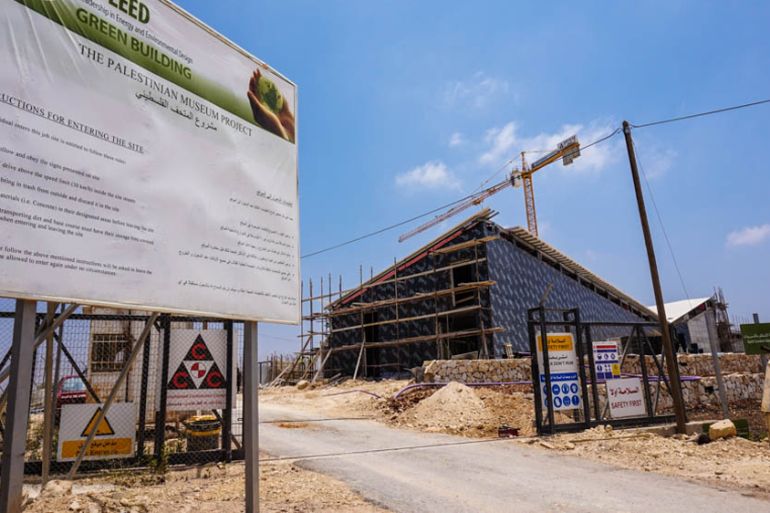West Bank museum to ‘keep Palestine’s memory alive’
The Palestinian Museum is expected to be complete by the end of the year and open to visitors by spring 2016.

Birzeit, occupied West Bank – The steady thud of hammers echoed throughout the valley and a large crane swung overhead as dozens of construction workers laboured in the summer heat.
Located on the campus of Birzeit University, a Palestinian academic institution in the Israeli-occupied West Bank, the half-finished building – the Palestinian Museum – is expected to be complete by the end of the year and open to visitors by spring 2016.
Keep reading
list of 4 itemsFire engulfs iconic stock exchange building in Denmark’s Copenhagen
Inside the pressures facing Quebec’s billion-dollar maple syrup industry
‘Accepted in both [worlds]’: Indonesia’s Chinese Muslims prepare for Eid
Though ground was not broken until early 2013, the idea for this museum dates back to the late 1990s, when the Welfare Association, a non-profit organisation focused on humanitarian development, first toyed with the idea of creating a museum to commemorate the Nakba – the dispossession and expulsion of hundreds of thousands of Palestinians from their historical homeland during Israel’s establishment.
Over time, the museum’s historical breadth expanded to include the last 200 years of Palestinian history.
Funded by a group of local and international donors, the Palestinian Museum seeks to incorporate the historical narratives of Palestinians from across the occupied Palestinian territories (the West Bank, including East Jerusalem, and the Gaza Strip, present-day Israel and the diaspora).
Rana Anani, the museum’s communications and media manager, explained that the events of 1948 were central to Palestinian history but do not tell Palestine’s story in its entirety.
|
|
“We decided to focus on the modern history of Palestine rather than one event, which will allow us to celebrate and explain Palestinian culture and different aspects of history,” she told Al Jazeera.
The construction of the museum, which is seeking to obtain certification as an environmentally friendly establishment, is taking place in two phases. First, by the time the museum opens next year, it will include a climate-controlled gallery space, an amphitheatre, cafeteria, gift shop and offices.
The second phase, which is projected to take 10 years, will expand permanent exhibitions and introduce classrooms, a library and an auditorium for artistic productions and film screenings.
The museum will include a variety of exhibitions, projects and archives drawing on academic research and oral histories, among other methods of historical inquisition.
One of the projects, Family Albums, will display photographs provided by Palestinians from across Palestine and the diaspora, including Palestinians in refugee camps in neighbouring countries and elsewhere.
“We’ve already received several photo albums from Palestinians in the US and Latin America,” Anani said. “When you open family albums, you don’t only find family pictures. They also highlight [historical] incidents, landscape, well-known historical characters and other things.”
Another project, The Timeline, will narrate the main events that defined the last 200 years of Palestinian history.
The main idea of the museum is to connect Palestinians in Palestine and those in the diaspora.
The inaugural exhibition, Never Part, will showcase items Palestinians abroad held onto in order to remember their ancestral homeland; it will be displayed in the West Bank, Lebanon, and Chile.
Exhibitions such as these seek to draw the participation of Palestinians who may not be able to physically reach Birzeit due to Israeli entrance restrictions to the West Bank.
Palestinians from across the globe have also been invited to submit to the website stories and photographs of items that they hold dear.
“The main idea of the museum is to connect Palestinians in Palestine and those in the diaspora,” Anani said, noting most Palestinians live outside of Palestine.
“[The museum] is an antithesis of what is happening on the political scene [and] the opposite of the Oslo Accords,” she added, referring to the agreement between Israel and the Palestine Liberation Organisation that led to the 1994 establishment of the Palestinian Authority in the West Bank and Gaza.
Yara Hawari, a British-Palestinian PhD candidate and researcher, said the inclusion of Palestinian citizens of Israel, who number an estimated 1.7 million people, and those in the diaspora is integral to such projects.
“For too long the discourse on ‘Palestine’ and the ‘Palestinians’ has been confined to the West Bank and Gaza,” she told Al Jazeera. “Excluding them from the Palestinian community and narrative leads us down a dangerous path of fragmentation and historical denial.”
“That’s why any projects or works by historians and scholars looking at the Palestinian people has to include the wider Palestinian community for it to be legitimate,” Hawari added.
RELATED: Memories preserved in the dark heart of Shatila
Although the Birzeit location will serve as the primary base, the museum has already started building connections to existing institutions and is seeking to establish satellite branches.
But not everyone has been supportive of the museum. Osama Attari, a student at Birzeit University, argues that establishing the museum in Birzeit, a Ramallah-area village, has pluses and minuses.
“I think that having a museum at Birzeit University is a good thing, but why was Birzeit chosen [as the primary site] for the museum?” he asked, arguing that Jerusalem, as the historical and cultural capital of Palestine, would be a more appropriate site.
Still, he said the museum would be beneficial for Palestinians, including Birzeit students. “The museum will benefit many students and others and provide them with easy access to information about Palestine,” he told Al Jazeera.
Anani says that in general, there has been much enthusiasm about the project, noting: “It is about keeping Palestine’s memory alive.”